- Retour accueil
- Vous êtes ici : Blog Ancient Egypt The Dendera Light protective magical energy in liquid form described in ancient Egyptian literature is the evaporative cooling fog of the Great Pyramid of Giza ©2021
The Dendera Light protective magical energy in liquid form described in ancient Egyptian literature is the evaporative cooling fog of the Great Pyramid of Giza ©2021
Publié par Bruno Coursol dans Ancient Egypt le 02/03/2022 à 16:23
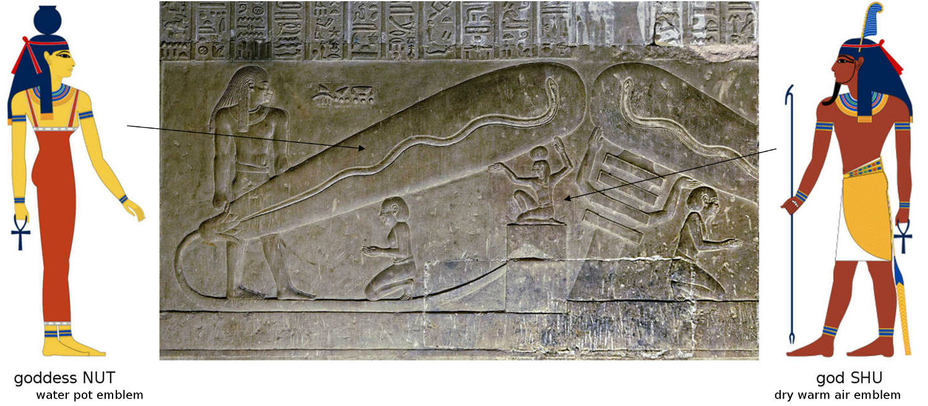
The Dendera Light is a fog of microdroplets that is creating cold from dry warm air by the evaporative power of liquid water. Ra's snake form, Harsomtus, and the lotus flower are representing the liquid water supply passing through the fog nozzle. In this stone relief of the Hathor temple, dry warm air is represented by god Shu holding the fog in form of a light bulb, and the fog of liquid water by ancient Egyptian goddess Nut. The Dendera Light Bulb being described as the womb of Nut.
As we'll see in the section of this post about ancient Egyptian god of the annual flooding of the Nile, Hapi : snakes mean water.
The ancient Egyptian Dendera Light "protective magical energy in liquid form" is the evaporative cooling fog
The fact that the Dendera Light is made of liquid water that transforms itself in a magical way, is exactly what are describing ancient Egyptians themselves :
[About the snake inside the Dendera Light Bulb] "The field surrounding Ra’s snake form is referred to in ancient Egyptian literature as protective magical energy in liquid form that all gods and pharaohs possess (Faulkner 1970*)." https://ahotcupofjoe.net/2016/11/dendera-light-bulb-and-bagdad-battery-nonsense/
*I'm not sure, but the excerpt might be from "The ancient Egyptian book of the dead / translated by Raymond O. Faulkner ; edited by Carol Andrews, 1972."
It also confirms the idea that ancient Egyptian magic was all about physics and chemistry
The field of magical energy in liquid form was qualified as protective, because the evaporative cold was produced to cool down Solvay reaction chambers that would create, from "pure magic" the purest mineral form of natron : the sodium carbonate that would be used for the mummification of the pharaoh.
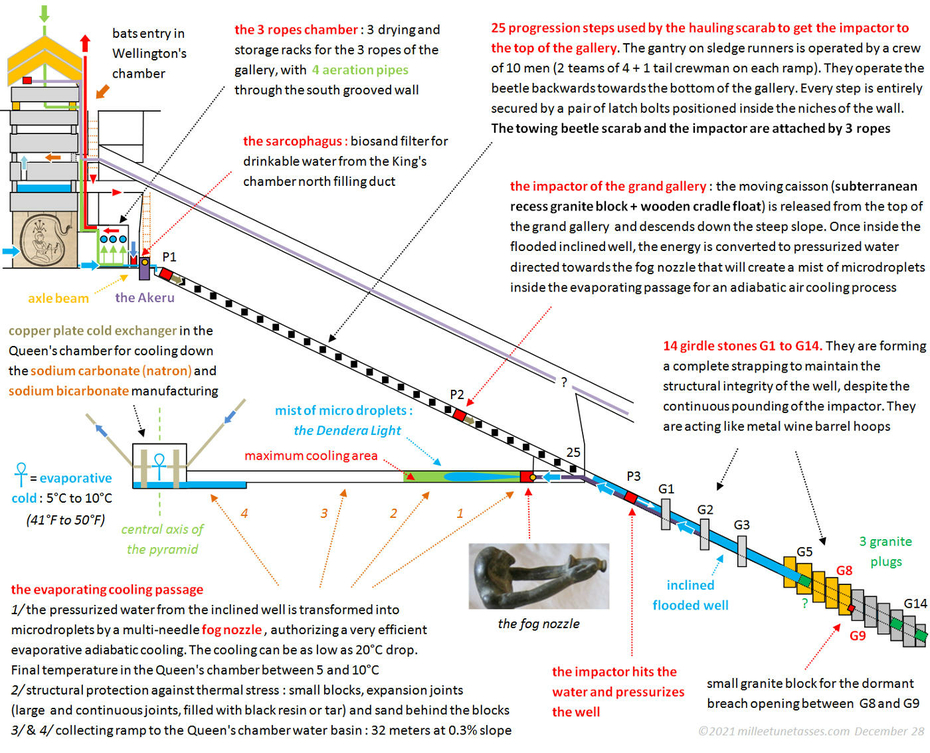
The known part of the Great Pyramid of Giza was an evaporative cooling unit for a Solvay-like chemical manufacturing of sodium carbonate (purest mineral form of the mummification salt natron), and sodium bicarbonate. The previous post about Akhenaten and Nefertiti, who represented themselves as Shu (the god of dry warm air and fogs) and Tefnut (the goddess of humidity and moisture, meaning : water in form of liquid droplets), explains why the Ankh sign is the representation of the evaporative cold that was stored in the Queen's chamber, the only chamber of the Great Pyramid, located on its central axis, suggesting that this chamber was of some major importance.
The Dendera Light is a representation of cold production from dry warm air by the evaporative power of water
According to academic explanations of the Dendera Light reliefs in the Hathor temple, god of dry and warm air Shu is holding the Dendera Light that is described as the womb of Nut.
"Stone reliefs in the Hathor temple at Dendera in Egypt, depict Harsomtus, in the form of a snake, emerging from a lotus flower (usually attached to the bow of a barge). A variation of this motif, the so-called dendera light, displays Harsomtus in an oval container called hn, which might represent the womb of Nut". https://en.wikipedia.org/wiki/Dendera_light
The so-called "oval container" which "might represent" the womb of goddess Nut, is actually the fog of microdroplets getting out of the fog nozzle and taking the shape of the horizontal passage of the Great Pyramid of Giza.
Additionally to the "protective magical energy in liquid form" described by ancient Egyptian themselves, we can affirm that this oval container is actually made of water for two reasons :
1 • Inside the oval container is a snake, Harsomtus (Sun god Ra in form of a snake), and snakes are representations of water, like suggested by representations of Hapi, the god of the annual flood of the Nile (see farther below the section on Hapi creating the snake in his cavern).
2 • Nut's emblem is a water-pot

Hapi, the god of the annual flooding of the Nile, in his cavern. Isis Temple, Philae Island, Egypt (Source : Rémih on Wikipedia). https://fr.wikipedia.org/wiki/Fichier:Hapy_Philae.JPG
Center : Sixth Cataract in 1908 by Sir Henry Rider Haggard. Right : Second cataract in 1854 by John Beasley Greene. https://en.wikipedia.org/wiki/Cataracts_of_the_Nile
1 • God of the Nile Hapi is the one creating the snakes : Nehebkau, the Great Serpent Apep, Atum, etc.
The academic point of view of the Hapi cavern (Isis Temple on Philae island)
The academic explanation of the Hapi cavern relief of the Philae temple of Isis, is that it represents the cataracts of the Nile. In all honesty, I'm starting to get used to these "scholar" wonderful interpretations, but this one is one of my favorites. I let you judge of the resemblance between Hapi's cavern and the real landscape created by the Nile cataracts…
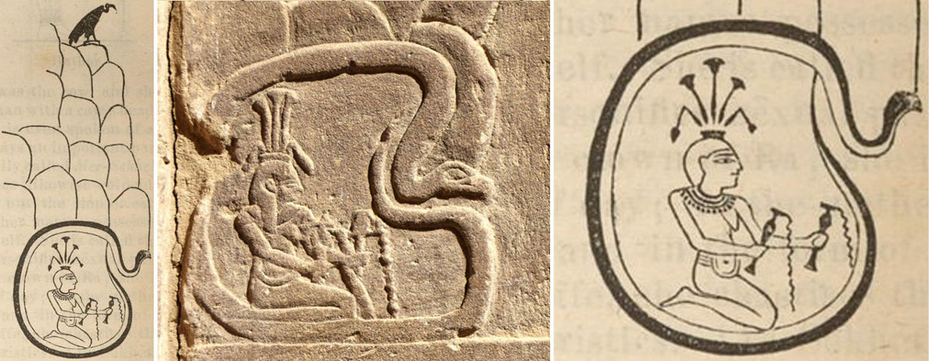
Line drawing of Hapi, the god of the annual flood of the Nile, from the Travelers in the Middle East Archive (TIMEA). https://fr.m.wikipedia.org/wiki/Fichier:Hapy_(1885)_-_TIMEA.jpg
Hapi is creating the snake of the cavern from the water of the Nile
I didn't really expect to find any proof of the hypothesis that snakes in ancient Egyptian religion were representations of the water used to operate the cold creation in the Great Pyramid of Giza, but it turns out that Hapi in his cavern is actually showing exactly that proof.
As we can see on the images of Hapi in his cavern, the ancient Egyptian god of the flood of the Nile, Hapi looks like he is pouring water inside a cavern kind of "protected" by a snake.
But there is no water inside the cavern and no water getting out of it : Hapi is actually "creating" the snake with the water from the Nile.
That is the proof that snakes in ancient Egyptian religion are really metaphors for water, like I've already suggested in the posts about Apep, Atum and Dendera.
Snakes mean water (from the Nile).
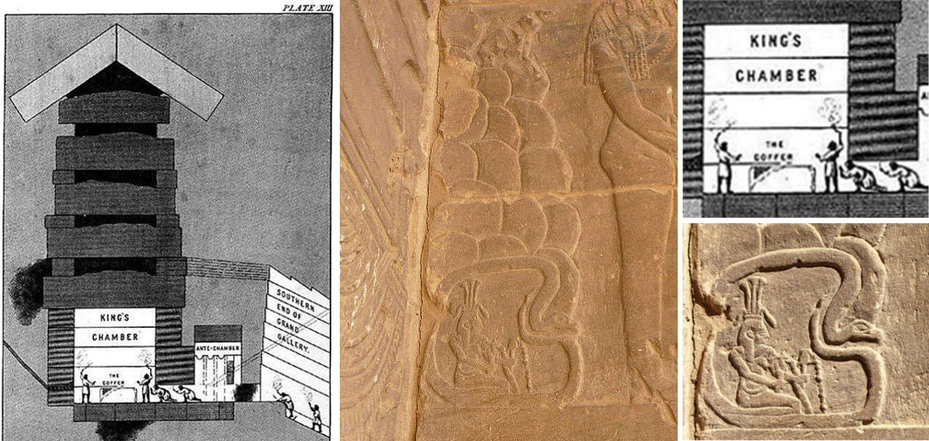
The King's chamber of the Great Pyramid of Giza was the main water tank of the entire operating of the pyramid for evaporative cold production ; for that reason the chamber had to be built entirely with massive granite blocks. https://en.wikipedia.org/wiki/Great_Pyramid_of_Giza#/media/File:Piazzi-plate_13.jpg
Hapi's reliefs : http://www.temples-egypte.net/philae/hadrien/paroiNord/registreMilieu.html
Hapi's Cavern is the King's chamber of the Great Pyramid of Giza
We've already seen in previous posts that the water used to power up the Great Pyramid was coming from the Nile. The fact that Hapi is related to the annual flood of the Nile, suggests that the Great Pyramid was only operated during this flood season.
The Hapi cavern with stone blocks piled up on one another, and Hapi completely imprisoned inside the structure can't be a representation of the cataracts :
"The Cataracts of the Nile are shallow lengths (or whitewater rapids) of the Nile River, between Khartoum and Aswan, where the surface of the water is broken by many small boulders and stones jutting out of the river bed, as well as many rocky islets. In some places, these stretches are punctuated by whitewater, while at others the water flow is smoother but still shallow." https://en.wikipedia.org/wiki/Cataracts_of_the_Nile
The blocks of the cataracts aren't piled up and the water doesn't pass under them ; but this piled up blocks immediately echoes the structure of the King's chamber of the Great Pyramid.
If you look closely, you'll see that proportions and shapes of the King's chamber and the "relieving chambers" are exactly the same. Even the passage between the King's chamber and the antechamber is represented in Hapi's cavern by the lower body of the snake (below its head).
Unfortunately, the line drawing of the relief is in my opinion very badly made : all lines are wrong, so just look at the original stone relief in order to really see the "copy paste" similarities of the two structures Hapi's cavern relief / King's chamber.

These images are representing the 4 steps of the operating of the Great Pyramid of Giza : 1/ the Hapi main water tank of the King's chamber, 2/ the impactor water slide like movement into the central gutter of the Grand Gallery, 3/ the Apep sequential ejection of pressurized water from the inclined well towards the evaporative cooling passage and 4/ the spitting of Shu and Tefnut by Atum. Please read the post about Apep for the details about 3/ and 4/
Snakes resulting of the Hapi's cavern Great Snake : Nehebkau, Kebechet, the Dendera snake, Apep, Atum, etc.
Hapi is pouring water inside the cavern and by doing so, he is creating the snake who is gonna be in many occasions a representation of the Nile water used inside the pyramid.
This Hapi cavern Great Snake will then be depicted as Apep, the Great Serpent of the Underworld as a representation of the waters of the inclined well that also allowed the impactor (the solar barque) to slide down the Grand Gallery's central gutter ; and as Atum, the serpent coming from the inclined well, that created Shu and Tefnut and who was about 200 liters of water ejected from the well every 20 minutes or so.
The vulture on top of the Hapi cavern
This vulture is in all the entire operating sequence of the Great Pyramid, the first representation of the snake eating animal metaphors we've already seen about cats, ibis, crocodile, falcons and mongoose.
The vulture, as a representation of the heat generated by the chemical reactions is waiting to eat the serpent, because the serpent represents the water that is creating the cold.
The vulture eats the snake = The heat eats the cold = The cooling of the Solvay process
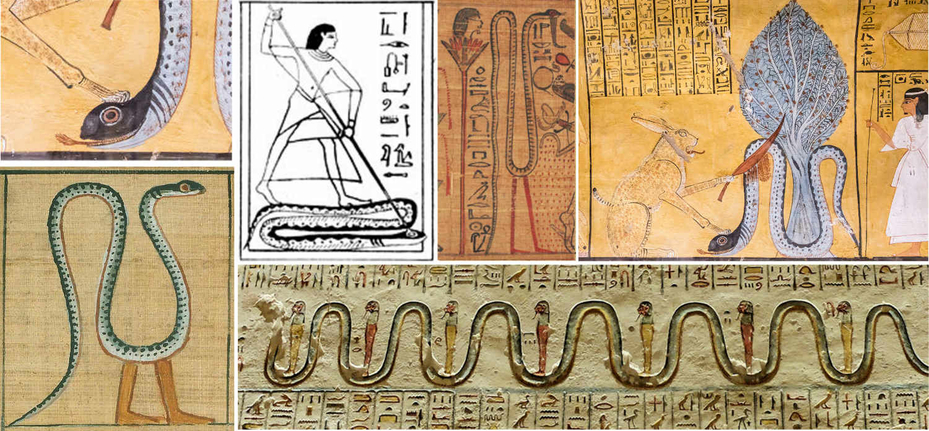
"Nehebkau (also spelled Nehebu-Kau) is the primordial snake god in ancient Egyptian mythology. Although originally considered an evil spirit, he later functions as a funerary god associated with the afterlife. […] Nehebkau was ultimately considered a powerful, benevolent and protective deity. In late mythology, he is described as a companion of the sun god Ra." https://en.wikipedia.org/wiki/Nehebkau
The pressurization of the inclined well metaphors by putting weight upon Apep
The first snake created "in the Hapi cavern" was Nehebkau, the primordial snake god who was associated with both Ra and the afterlife because of his role in the mummification process and the operating of the Great Pyramid.
The patchwork of images above is to demonstrate the principal meaning of the serpent in ancient Egyptian religious art : the pressurization of the inclined well by the sycamore wood impactor. That crucial point is represented in many ways, but every time by applying weight on the body of the snake, whether it is the weight of the sycamore tree, the weight of the front paw of the big cat goddess Bastet, or the weight of entire human bodies.
In my opinion, the "walking snake" representations of the primordial serpent Nehebkau, are precisely that : metaphors of the pressurization of the well.
Legs are referring to the weight that created pressure on the snake, whether they are onto the snake (black and white Spearing of Apep drawing, from the Papyrus of Nekhtu-Amen) or below the body of the snake (Nehebkau drawings).
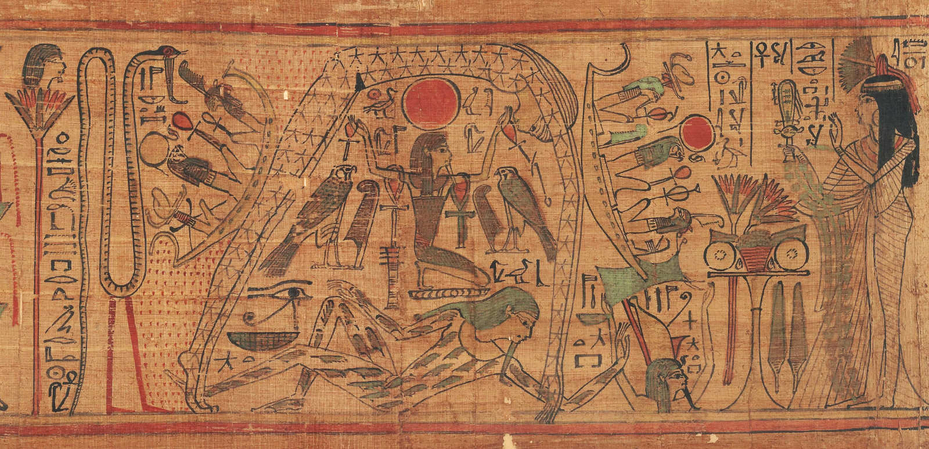
Papyrus mythologique de Tanytamon, Egyptien 172. Bibliothèque nationale de France, département des manuscrits (color and luminosity modified on gimp) : https://gallica.bnf.fr/ark:/12148/btv1b8304598h
The link between the water of the Nile (Hapi) and the Dendera Light womb of Nut : Geb, the "god of the earth"
"Hapi (Ancient Egyptian: ḥʿpy) was the god of the annual flooding of the Nile in ancient Egyptian religion. […] Hapi was not regarded as the god of the Nile itself but of the inundation event. He was also considered a "friend of Geb", the Egyptian god of the earth." https://en.wikipedia.org/wiki/Hapi_(Nile_god)
In my opinion, Geb is actually a lot more than just a friend, because Geb, as Hapi and Nut, is all about water.
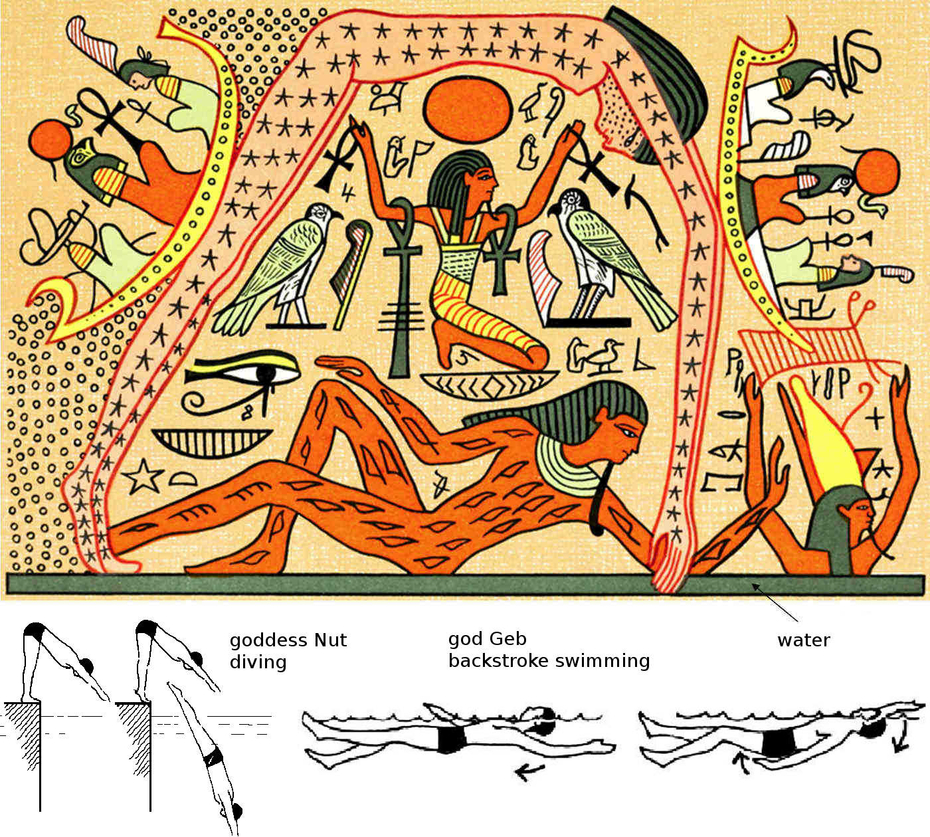
Geb and Nut scene with god Shu in the center, holding goddess Nut : https://fr.wikipedia.org/wiki/Fichier:Geb_and_Nut03.png. Backstroke swimming drawing : https://commons.wikimedia.org/wiki/File:Backstroke_(PSF).png
In the Geb and Nut scene, everything is about water
• Geb (bottom of the image) is swimming on his back (with a nearly perfect match with the backstroke swimming drawings, above)
• Nut (top of the image) is diving into the water
• The 2 solar barques are representations of the ascending and descending impactor inside the Grand Gallery
• Another character is half immersed into the water and is throwing a fishing net, most probably as a metaphor of the solar barque impactor recovery from the inclined well.
Nut and Tefnut as well as Geb and Hapi are all referring to water.
2 • The real meaning of the Geb and Nut scene : the water cycle between liquid and vapor phases
In some ways, even Shu (the god of dry and warm air) is about water :
Geb is shown swimming, that means that he is a representation of water in a liquid form. But in some paintings, Geb is also represented with feathers all over his body. Feathers are the emblem of Shu, so it means that this liquid water is or can be associated with dry and warm air.
The result is Shu represented "separating" Geb from Nut. And we've seen that Nut's emblem is the water-pot, a little container where you can put a part of something, in that case : a portion of water.
"Nut (Ancient Egyptian: nwt), also known by various other transcriptions, is the goddess of the sky, stars, cosmos, mothers, astronomy, and the universe in the ancient Egyptian religion. She was seen as a star-covered nude woman arching over the Earth, or as a cow. She was depicted wearing the water-pot sign (nw) that identifies her."
"Tefnut (tfnwt) is a deity of moisture, moist air, dew and rain in Ancient Egyptian religion."
Wikipedia's page on Nut : https://en.wikipedia.org/wiki/Nut_(goddess) and on Tefnut : https://en.wikipedia.org/wiki/Tefnut
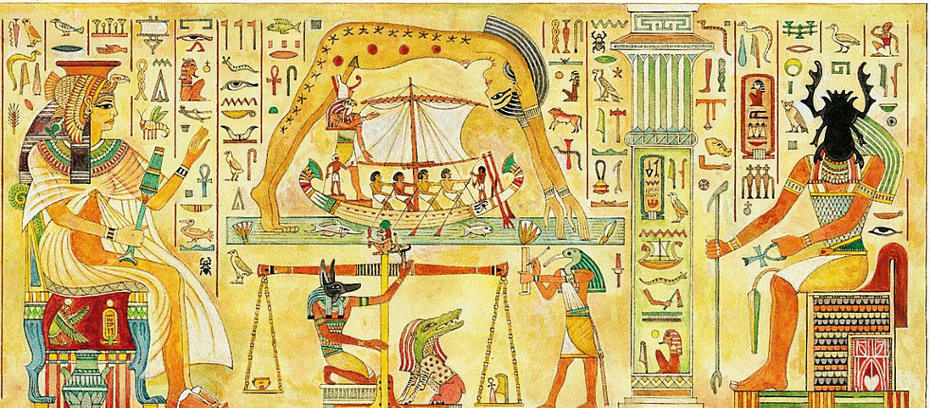
On this scene representing Nut, and contrary to the first one above with Geb and Shu, water is also represented. In the first scene, water is not clearly represented, it is just suggested by the solar boats, the fisherman, the fishing net and the postures of Geb and Nut. Goddess of the sky Nut is clearly diving into the water. Geb is not represented because he is the water. Shu is also not represented because he is the sail of the boat.
Shu is not separating Geb from Nut, Shu is holding Nut in the air : Shu is absorbing moisture and accumulating humidity
In my opinion, that scene of Geb and Nut separated from each other by Shu is actually representing the cycle of water between its liquid form and its evaporated form.
Nut is getting out of the water (her lower body) and then comes back in with her upper body.
So why Nut is described as the goddess of the sky and Geb as the god of the earth ?
We've just seen that Nut and Geb were both representing water, but in two different forms : liquid water (Geb) and evaporated water (Nut). Once you take the water out of the equation, the only elements remaining is the earth (where the liquid water is) and the sky (where humidity and moisture are).
This is why today, egyptologists say that Geb is the god of the earth and Nut the goddess of the sky.
They are just missing the water.
Why nobody is describing the relation of Nut with water despite her water-pot emblem and the name similarity with Tefnut ?
I think the reason is that nobody really wants to talk about the water. It is that simple. But if you do that, not only you can't understand the Dendera Light, but you can't understand "god of the earth" Geb either.
For egyptologists, water doesn't deserve to be studied for anything else but agriculture, even though the expression "the power of water" appears in many occasions in the Book of the Dead, as well as the one we've just seen : "the protective magical energy in liquid form" about the Dendera Light.
If you don't think about water in the famous Geb and Nut paintings where Shu is represented "separating" them both, you can't understand their respective postures.
If you do think about water you understand that :
1 • Geb is swimming : Geb is a representation of liquid water (on earth) = god of the water on earth
2 • Nut is diving into the water from the air : Nut is a representation of humidity / moisture = goddess of water in the sky
3 • Shu (god of dry warm air and fog) is the one receiving / holding / sustaining / supporting that humidity and he is the one separating them both
In short, the Geb and Nut scene is all about the evaporative process that is the motor of the evaporative cooling

No one ever questioned the fact that Nut, the "goddess of the sky" had a water-pot emblem ?
According to Wikipedia's page on Tefnut, 'tfn' means 'to spit : "Literally translating as "That Water",[2] the name Tefnut has been linked to the verb 'tfn' meaning 'to spit'[3] and versions of the creation myth say that Ra (or Atum) spat her out and her name was written as a mouth spitting in late texts [4]". Source : https://en.wikipedia.org/wiki/Tefnut
But according to https://en.wiktionary.org/wiki/tfn, 'tfn' means orphan : "Conventional anglicization: tefen. orphan".
The correct translation for 'to spit' would be 'tf' and not 'tfn' : "Etymology 2 : (intransitive) to spit (+ m: to spit (something) out) [Pyramid Texts, rarely later]". https://en.wiktionary.org/wiki/tf
Tefnut = 'to spit' + Nut. It means that Nut is referring to water
If Wiktionary is right over Wikipedia, that means that Tefnut, 'tfnwt' is 'tf' + 'nwt' = to spit + 'nwt'
If Tefnut means "that water" and is referring to spat water, then Nut 'nwt' is referring to water itself. Hence the water-pot emblem of goddess Nut.
The theoretical evaporative process of the cold production
What is remarkable with the Geb and Nut scene, is that it is a representation of the evaporative process that is producing the cold inside the Great Pyramid.
We've already seen in the first post about the Dendera Light (June 5th 2021), that ancient Egyptians loved to show and explain what they were doing, in their own way of course : they've represented a snake spitting out its venom on one side of a relief, and just next to it, they've represented the Dendera Light with the same snake inside the bulb, and by doing so they were saying that the Dendera Light was created by the venom of the snake, as a metaphor of the spat water getting out of the fog nozzle, under pressure and in the form of microdroplets.
The sociological modern drama interpretation of Geb and Nut
"There is speculation between Shu and Geb and who was the first god-king of Egypt. The story of how Shu, Geb, and Nut were separated in order to create the cosmos is now being interpreted in more human terms; exposing the hostility and sexual jealousy. Between the father-son jealousy and Shu rebelling against the divine order, Geb challenges Shu's leadership. Geb takes Shu's wife, Tefnut, as his chief queen, separating Shu from his sister-wife. Just as Shu had previously done to him." https://en.wikipedia.org/wiki/Nut_(goddess)
My comment : "Best soap ever !"

God of the earth Geb with the head of a snake, and goddess of the sky Nut in the papyrus EA10018,2 at the British Museum : https://www.britishmuseum.org/collection/object/Y_EA10018-2
Geb was seen as the father of all snakes and also referred to water
• This idea that Geb was actually referring to water is reinforced by the fact that water, or absence of water (barren desert, drought…), is often mentioned about him. Excerpts are from : https://en.wikipedia.org/wiki/Geb
"As a chthonic deity, he […] became naturally associated with the underworld, fresh waters and with vegetation."
"Geb could also be regarded as personified fertile earth and barren desert."
This last excerpt is particularly interesting because it says that Geb is representing both the fertile earth and the barren desert, and to get from one to the other, you just need to take out all the water. That is precisely the meaning of the Geb and Nut scene : liquid water evaporating itself into the air (into the sky goddess Nut).
• Geb was the father of snakes and often represented with the head of a snake.
"Geb was frequently feared as father of snakes (one of the names for snake was s3-t3 – "son of the earth"). In a Coffin Texts spell Geb was described as father of the mythological snake Nehebkau of primeval times."
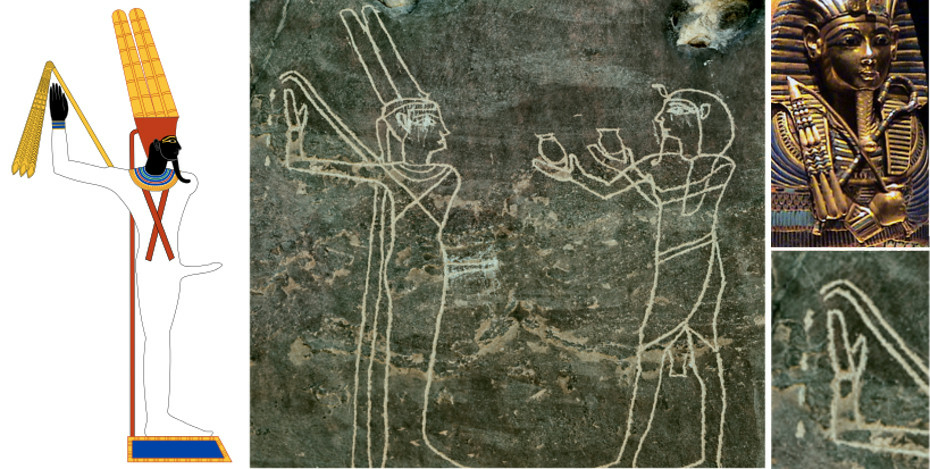
Wadi Hammamat stone reliefs representing the ancient Egyptian god Min and revealing the real nature of the flail (nekhakha), Dynasty 17. Photographed by Kairoinfo4U and posted on flickr : https://www.flickr.com/photos/manna4u/25999304796/in/photostream/
Min god page on Wikipedia : https://en.wikipedia.org/wiki/Min_(god)
Water is really everywhere in ancient Egyptian religious art, even in the most surprising places
We've already seen that snakes were representations of the water of the Nile, used inside the Great Pyramid of Giza ; but the flail is also made of water.
In academic representations of the flail that we can find in temples or in other official context, the artists were obviously obligated to follow precise guidelines, but what we would probably call today, ancient Egyptian street artists weren't, and what some of them did carved into stone, is completely out of lines, so to speak.
The reliefs shown here, are coming from Wadi Hammamat and are representing god Min.
"Wadi Hammamat was a major mining region and trade route east from the Nile Valley in ancient times, and three thousand years of rock carvings and graffiti make it a major scientific and tourist site today." https://en.wikipedia.org/wiki/Wadi_Hammamat
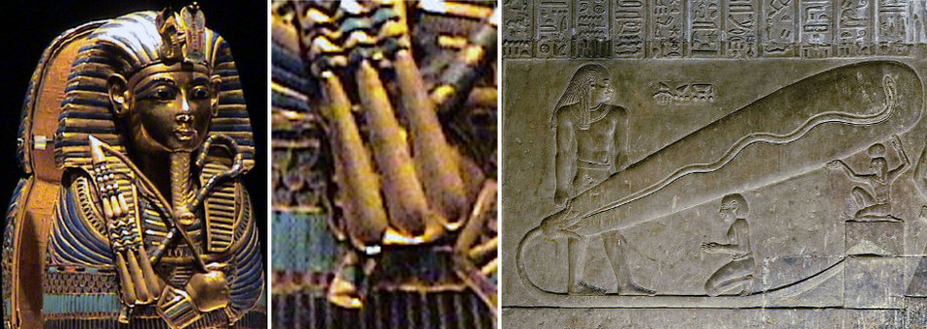
The crook and flail on the coffinette of Tutankhamun : https://upload.wikimedia.org/wikipedia/commons/7/7c/Tut_coffinette.jpg
The flail symbol of the kings of ancient Egypt were also referring to water (or saline solution)
So, not only the Wadi Hammamat's reliefs are depicting water / liquid getting out of what really looks like a hollow pipe, but the shape of the flail parts itself is identical to the shape of the Dendera Light, the fog of liquid microdroplets creating the evaporative cold.
What is also interesting to see, is that on these Min representations with erect penis, once again appears the metaphor of a pressurized liquid expelled and projected into droplets.
"The crook (heka) and flail (nekhakha) were symbols used in ancient Egyptian society. They were originally the attributes of the deity Osiris that became insignia of pharaonic authority. The shepherd's crook stood for kingship and the flail for the fertility of the land. [...] Traditionally crossed over the chest when held, they probably represented the ruler as a shepherd whose beneficence is formidably tempered with might." https://en.wikipedia.org/wiki/Crook_and_flail
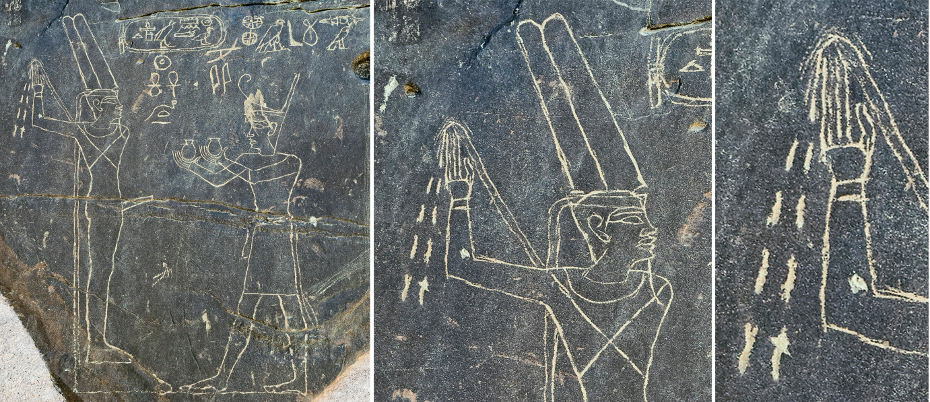
Wadi Hammamat: Dynasty 11, Nebhepetre Mentuhotep II. Photographed by Kairoinfo4U and posted on flickr : https://www.flickr.com/photos/manna4u/25932728632/in/photostream/
On the Wadi Hammamat's reliefs, there is clearly liquid getting out of some kind of pipe, but from that it is still very hard to imagine the exact representation meaning of what we call today a flail.
Is the flail referring to a fog nozzle used to produce cold, or 3 nozzles? Or is it referring to the cooling of the Solvay chambers themselves? Is the liquid getting out of the tube water, or saline solution?

All the posts on the theory of an ancient Egyptian chemical manufacturing quest, and how an entire religion was built to worship and glorify this human, scientific and technological accomplishment : click on "LE BLOG" button

The Dendera Light on the reliefs at the Hathor temple is the fog of microdroplets of the theory
The Dendera Light Bulb / The double outline of the characters offering the cold / The arms and Djed Pillar
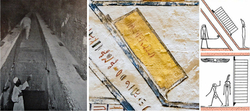
The secret Hauling cavern of the Underworld : the Grand Gallery
The latchbolt representation by Sokar
The axle beam representation by Aker on the Grand Gallery's top platform
The grasp of the Akeru
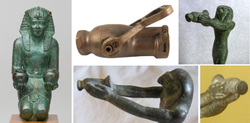
The fog nozzle of the evaporative cooling passage in the Great Pyramid
Horus represented holding the fog nozzle that transformed the pressurized water of the inclined well into a fog of microdroplets, after it had been hit (rammed) by the impactor of the Grand Gallery
Pharaohs represented holding the 2 final products of the Solvay process
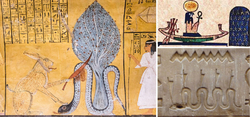
The Great Serpent Apep (Apophis)
The fight between Sun god Ra and Apep / The restraint of the inclined well waters / The equal length cuts of Apep
The 14 Girdle Stones of the inclined well / The Dormant breach and the draining of the inclined well
• TAWERET : the Lady of the Well
• ATUM and the real meaning of snake representations in ancient Egypt
• THE DENDERA LIGHT and the evaporative cooling fog of the Great Pyramid of Giza
• AKHENATEN and NEFERTITI creating the evaporative cooling fog
• THE HIDDEN HAULING CAVERN of the Underworld
• The EYE OF HORUS and the natron manufacturing failures before evaporative cooling
• THE GREAT SERPENT GOD APEP (APOPHIS) and the pressurized waters of the inclined well
• IMHOTEP'S PYRAMID OF THE COLD and the fog nozzle of the Great Pyramid
• THE PTAH-SOKAR-OSIRIS FIGURE representations of the impactor
• NEFERTEM and the creation of the cooling fog
• SCARAB AMULETS representing the hauling beetle of the Grand Gallery
• THE DISC OF SABU as a schist dome shaped and perforated plate designed for counterflow chemical reactions for natron manufacturing (by a Solvay-like process)
• THE DENDERA LIGHT BULB and the evaporative cooling
• SNÉFROU : la quête de l'immortalité d'un pharaon révolutionnaire (Français)
• SARCOPHAGE de la GRANDE PYRAMIDE : un filtre à sable dont le prototype se trouve dans la pyramide rhomboïdale, avec herse d'alimentation et le sable encore présent aujourd'hui (Français)
• LE CHAMBRE FUNÉRAIRE DE LA PYRAMIDE ROUGE : un four à chaux pour la fabrication de la forme minérale pure du Natron par un procédé Solvay à l'ammoniac "primitif" (Français)
• LE PUITS OBLIQUE INONDÉ (Français)
• LE COULOIR HORIZONTAL DE REFROIDISSEMENT (Français)
• THE GREAT PYRAMID OF GIZA WAS A COOLING UNIT FOR NATRON MANUFACTURING, the purest mineral form of the salt used for the mummification of the pharaohs
Poster un commentaire
